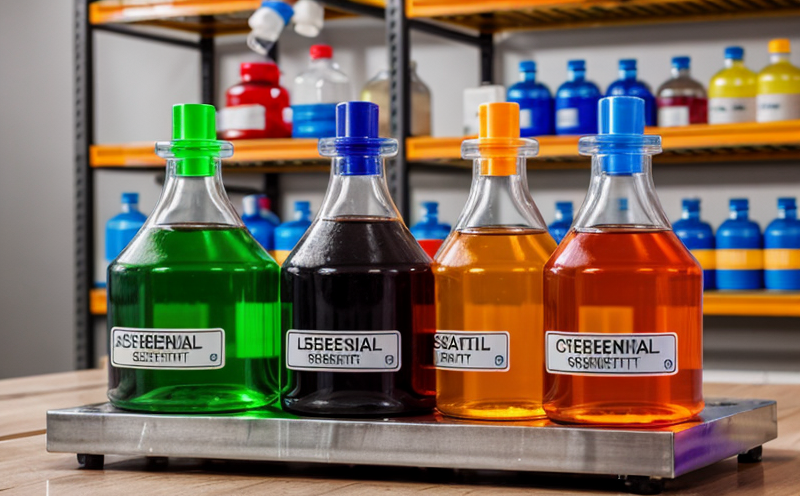DBP Phthalate Testing in Household Goods
Phthalates are a group of chemicals widely used in various consumer products due to their plasticizing properties. Di-Butyl Phthalate (DBP) is one such phthalate ester that enhances the flexibility and durability of plastics, which makes it a common additive in household goods like toys, flooring, personal care items, and furniture.
However, DBP has been identified as a potential health hazard. Exposure to high levels of DBP can lead to reproductive toxicity, developmental effects, and other adverse health outcomes. Regulatory authorities around the world have implemented stringent regulations to control the use of DBP in consumer products. Compliance with these regulations is not only essential for legal reasons but also helps to build trust among consumers.
The testing of DBP in household goods involves several critical steps, including sample preparation and analysis. Samples are typically prepared by extracting the suspected phthalates from the product using solvents like dichloromethane or hexane. The extract is then analyzed using analytical methods such as gas chromatography-mass spectrometry (GC-MS) to quantify the presence of DBP.
Accurate and reliable testing is crucial for ensuring compliance with international standards such as ISO 8152, ASTM D7929, and EN 14362. These standards provide detailed protocols for sample preparation, extraction techniques, and analytical methods that laboratories must follow to ensure the accuracy of their results.
The laboratory uses state-of-the-art instruments like gas chromatographs equipped with mass selective detectors (GC-MS/MS) which offer high sensitivity and selectivity in detecting even trace amounts of DBP. The use of such advanced technology ensures precise quantification and reliable data, making the test results highly credible.
Sample preparation is a critical step that requires meticulous attention to detail. It involves selecting appropriate solvents for extraction based on the product's matrix and ensuring thorough mixing to avoid any bias in the testing process. Once the extraction is complete, it is filtered through a fine filter to remove any insoluble particulates.
The extracted solution undergoes further purification steps if necessary before being injected into the GC-MS/MS system for analysis. The chromatogram generated from this step provides peaks corresponding to different compounds present in the sample. By comparing these peaks with known standards, analysts can identify and quantify DBP accurately.
Following accurate identification and quantification of DBP, the laboratory reports the findings according to specified formats provided by relevant regulatory bodies such as the European Union's REACH regulation or the California Proposition 65. The report includes detailed information about the tested product, the presence and concentration levels of DBP detected, and compliance status with applicable regulations.
- Compliance with international standards ensures consistency across different jurisdictions.
- Use of advanced analytical techniques guarantees accurate quantification even at low concentrations.
- Stringent quality control measures ensure reliability and reproducibility of results.
- Collaboration between laboratories and clients fosters better understanding and implementation of testing requirements.
Why It Matters
Testing for DBP in household goods is crucial because it directly impacts public health. Exposure to high levels of DBP can have serious implications, particularly for children who are more susceptible due to their developing bodies. By ensuring that products do not contain excessive amounts of DBP, manufacturers and retailers can help protect consumers from potential risks.
From a legal perspective, compliance with regulations such as the EU's REACH or California Proposition 65 is mandatory for businesses operating within these regions. Failure to comply can result in heavy fines and damage to reputation. Regular testing helps companies stay ahead of regulatory changes and maintain compliance proactively.
For quality managers and R&D engineers, understanding DBP levels in household goods allows them to make informed decisions about material selection and formulation adjustments. This knowledge enables the development of safer products that meet both legal requirements and consumer expectations.
Compliance with regulations also enhances corporate social responsibility (CSR) efforts by demonstrating a commitment to environmental protection and health safety. This can positively influence brand image and customer loyalty, thereby boosting market competitiveness.
Environmental and Sustainability Contributions
- Promoting Sustainable Consumption: By ensuring that household goods meet stringent DBP testing standards, the industry promotes sustainable consumption patterns. Consumers are more likely to choose safer products, driving demand for environmentally friendly alternatives.
- Reduction in Waste: Safer products contribute to reduced waste generation since they pose less risk during disposal or recycling processes.
- Enhanced Recycling Potential: Products free from harmful substances like DBP can be more easily recycled, thereby extending their lifecycle and reducing the need for raw material extraction.
Competitive Advantage and Market Impact
In today’s competitive market, maintaining a strong reputation for product safety is crucial. Companies that demonstrate leadership in DBP testing not only meet regulatory requirements but also set benchmarks for industry standards. This proactive approach can differentiate them from competitors who may lag behind in implementing such measures.
Consumer trust plays a vital role in building brand loyalty and market share. By consistently delivering safe products, companies earn the confidence of their customers, which translates into long-term business success. Furthermore, early adoption of new testing methods or compliance with emerging regulations can put businesses at an advantage over slower competitors.
The ability to adapt quickly to changing regulatory landscapes also enhances a company’s agility and resilience in the face of market fluctuations. This flexibility allows them to navigate challenges more effectively while capitalizing on opportunities for growth.





